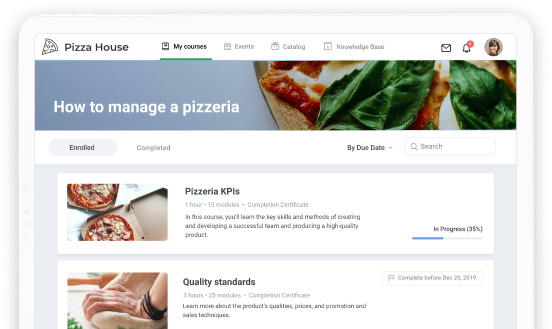6 Tips To Find The Ideal Difficulty Level For Your Online Training Activities

Are employees bored by easy simulations that don’t challenge them enough? Do they click away from the online training course, frustrated by overly complex branching scenarios? In this article, I’ll share 6 tips to find the ideal difficulty level for your online training activities.
How To Find The Ideal Difficulty Level For Your Online Training Activities
Most employees are already resistant to online training. They perceive it as tedious or boring. But this is primarily due to the fact that they simply aren’t challenged enough. Employees are merely going through the motions, instead of putting their skills and knowledge to the test, or using their broad range of experience to tackle real-world simulations and scenarios. However, there is a point where the challenge is too great, which forces online learners to disengage. Here are 6 tips on how to find the ideal difficulty level for your online training activities.
1. Online Surveys And Questionnaires
Surveys and questionnaires are some of the oldest ways of collecting data for research purposes. All you need to do is send the online surveys or questionnaires to your remote workforce and ask them to provide their honest opinion. In the past, you’d have to hire someone to compile the results, but now there is software that does the analysis for you. The information gathered will help you to know the specific stress points in your online training course. Then come up with ways to make it easier for the online learners to comprehend the concepts and apply the skills without stressing them out.
2. Analyze The Online Training Course From The Learners’ Perspective
You won’t know if the online training course needs to be improved if you only focus on the set goals and objectives. Take some time off and analyze the online training course from your learners’ perspective to get the complete picture. In the process, you will get an eye-opening view of what online learners feel and go through as they participate in your online training course. Especially how they interact with the online training content and which aspects provide the most significant “stumbling blocks”. For example, the compliance branching scenario takes far too long to complete, and it involves topics or skills that haven’t yet been explored.
3. Conduct Continuous Online Assessments
Continuous online assessments will help you to determine if online learners actually understand the concepts and ideas covered in the online training course. Since you are offering the course online, you won’t be able to schedule on-site evaluations. But that’s where qualitative virtual assessments come into play. For example, if you are offering an online marketing course, you test their ability to develop an effective promotional strategy within an online training simulation. They must work with a virtual team to identify the best course of action and choose the best techniques. Make sure that you mark the tests and provide constructive feedback so that online learners know which areas they need to work on. The results of the online test will help you identify the ideal difficulty level. For instance, many online learners lack the necessary skills to complete the simulation. This indicates that the related online training activities either aren’t challenging enough or are far too easy.
4. Evaluate Learners’ Behavior
Learners’ behavior during the online training course can also help you identify the ideal difficulty level. One of your most valuable diagnostic tools is your LMS. Specifically, the reports and data visualizations that allow you to track individual progress. These LMS metrics can shed light on areas of the online training course that offer too little or too much challenge. For example, the customer service serious game has low engagement scores. Online learners are clicking away from the game within the first minute or two. Or they are taking much longer to complete the online training activity than expected. This is a tell-tale sign that the difficulty level is askew.
5. Test Drives
Invite learners to test drive the online training activities in question. For example, the task-based simulation that online learners struggle with, according to your LMS reports. Then ask them to participate in a brief interview. During the one-on-one feedback sessions, pay close attention not only to what the online learners say verbally but also the non-verbal signs. You can learn a lot from the tone of the voice they use to answer direct questions as well as their facial expressions. You can also opt for focus groups if you’d like to gather more data at once. Or your learners may feel uncomfortable expressing their opinions one-on-one. Another option is anonymous online polls or questionnaires that allow them to provide feedback more openly.
6. Consider The Source
All the aforementioned tips can help you identify the perfect difficulty level for your online training. However, you must also consider why online learners are struggling with certain online training activities. In some cases, it may not be that that the online training content is too challenging, but that online learners lack the necessary motivation. They aren’t progressing as quickly as they should be because they are unaware of the benefits or cannot focus on the task at hand. Thus, LMS metrics, online surveys, and assessments will indicate that the online training activity is too challenging. But is it really the design and subject matter, or an issue with the online learner? You must consider all the factors involved, such as the learners’ background, emotional state, and sources of motivation. For instance, only a small percentage of your audience is unable to complete an online training simulation in the specified time. This is usually indicative of a more isolated problem among that target group. Not necessarily your entire workforce.
Apply the above 6 tips at different phases of the online training process to get a clear perspective of your employees’ comprehension and make the necessary adjustments. Don’t shy away from asking for their feedback after each online training activity to analyze each component individually. Identifying the trouble spots early on can help you retain your top talent and achieve the desired outcomes, as employees get the knowledge they need without frustration or boredom standing in the way.
About the Author

Christopher Pappas, Founder of the eLearning Industry
Christopher Pappas is founder of The eLearning Industry’s Network, which is the largest online community of professionals involved in the eLearning Industry. Christopher holds an MBA, and an MEd (Learning Design) from BGSU. eLearning Blogger | EduTechpreneur | eLearning Analyst | Speaker | Social Media Addict
